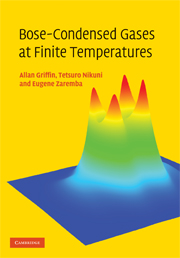Book contents
- Frontmatter
- Contents
- Preface
- 1 Overview and introduction
- 2 Condensate dynamics at T = 0
- 3 Coupled equations for the condensate and thermal cloud
- 4 Green's functions and self-energy approximations
- 5 The Beliaev and the time-dependent HFB approximations
- 6 Kadanoff–Baym derivation of the ZNG equations
- 7 Kinetic equation for Bogoliubov thermal excitations
- 8 Static thermal cloud approximation
- 9 Vortices and vortex lattices at finite temperatures
- 10 Dynamics at finite temperatures using the moment method
- 11 Numerical simulation of the ZNG equations
- 12 Simulation of collective modes at finite temperature
- 13 Landau damping in trapped Bose-condensed gases
- 14 Landau's theory of superfluidity
- 15 Two-fluid hydrodynamics in a dilute Bose gas
- 16 Variational formulation of the Landau two-fluid equations
- 17 The Landau–Khalatnikov two-fluid equations
- 18 Transport coefficients and relaxation times
- 19 General theory of damping of hydrodynamic modes
- Appendix A Monte Carlo calculation of collision rates
- Appendix B Evaluation of transport coefficients: technical details
- Appendix C Frequency-dependent transport coefficients
- Appendix D Derivation of hydrodynamic damping formula
- References
- Index
3 - Coupled equations for the condensate and thermal cloud
Published online by Cambridge University Press: 06 October 2009
- Frontmatter
- Contents
- Preface
- 1 Overview and introduction
- 2 Condensate dynamics at T = 0
- 3 Coupled equations for the condensate and thermal cloud
- 4 Green's functions and self-energy approximations
- 5 The Beliaev and the time-dependent HFB approximations
- 6 Kadanoff–Baym derivation of the ZNG equations
- 7 Kinetic equation for Bogoliubov thermal excitations
- 8 Static thermal cloud approximation
- 9 Vortices and vortex lattices at finite temperatures
- 10 Dynamics at finite temperatures using the moment method
- 11 Numerical simulation of the ZNG equations
- 12 Simulation of collective modes at finite temperature
- 13 Landau damping in trapped Bose-condensed gases
- 14 Landau's theory of superfluidity
- 15 Two-fluid hydrodynamics in a dilute Bose gas
- 16 Variational formulation of the Landau two-fluid equations
- 17 The Landau–Khalatnikov two-fluid equations
- 18 Transport coefficients and relaxation times
- 19 General theory of damping of hydrodynamic modes
- Appendix A Monte Carlo calculation of collision rates
- Appendix B Evaluation of transport coefficients: technical details
- Appendix C Frequency-dependent transport coefficients
- Appendix D Derivation of hydrodynamic damping formula
- References
- Index
Summary
In contrast with Chapter 2, in this chapter we include the dynamics of the thermal cloud. As noted in Chapter 1, we treat the noncondensate atoms using the simplest microscopic model approximation that captures the important physics. In particular, we consider only temperatures high enough (T ≥ 0.4TBEC) that the noncondensate atoms can be described by a particle-like Hartree–Fock (HF) spectrum. To extend the analysis to very low temperatures is in principle straightforward (see Chapter 7). However, the details are more complicated since the excitations of the thermal cloud take on a collective aspect (i.e. a Bogoliubov-type quasiparticle spectrum must be used). In trapped Bose gases, the HF single-particle spectrum gives a good approximation down to much lower temperatures than in the case of uniform Bose gases, as first emphasized by Giorgini et al. (1997).
In Section 3.1, we derive a generalized form of the Gross–Pitaevskii equation for the Bose order parameter Φ(r, t) that is valid at finite temperatures. It involves terms that are coupled to the noncondensate component (the thermal cloud) and thus its solution in general requires one to know the equations of motion for the dynamics of the noncondensate atoms. In Section 3.2 we restrict ourselves to finite temperatures high enough that the noncondensate atoms can be described by a quantum kinetic equation for the single-particle distribution function f(p, r, t). A detailed microscopic derivation of this kind of kinetic equation is given in Chapters 6 and 7 using the Kadanoff–Baym Green's function formalism.
A characteristic feature of a Bose-condensed gas is that the kinetic equation governing f(p, r, t) involves a collision integral C12[f, Φ] describing collisions between condensate and noncondensate atoms.
- Type
- Chapter
- Information
- Bose-Condensed Gases at Finite Temperatures , pp. 32 - 53Publisher: Cambridge University PressPrint publication year: 2009



